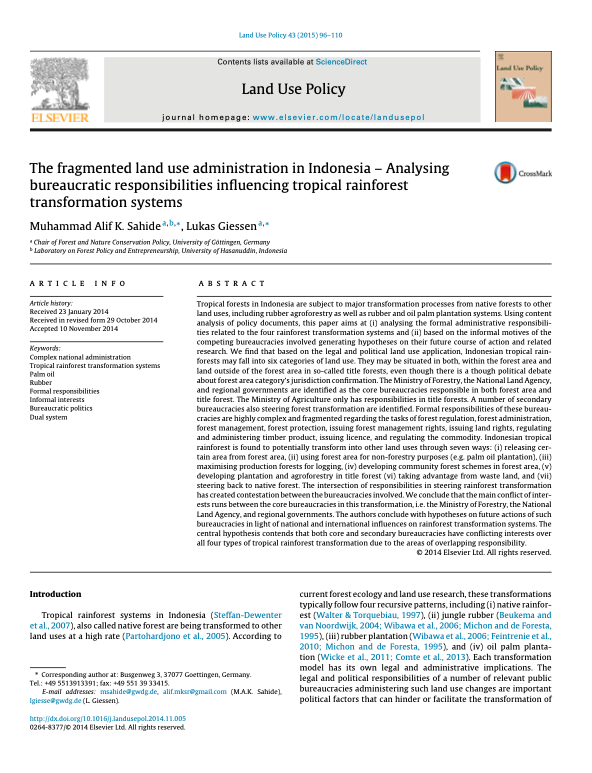Location
Land Use Policy is an international and interdisciplinary journal concerned with the social, economic, political, legal, physical and planning aspects of urban and rural land use. It provides a forum for the exchange of ideas and information from the diverse range of disciplines and interest groups which must be combined to formulate effective land use policies. The journal examines issues in geography, agriculture, forestry, irrigation, environmental conservation, housing, urban development and transport in both developed and developing countries through major refereed articles and shorter viewpoint pieces.
Land Use Policy aims to provide policy guidance to governments and planners and it is also a valuable teaching resource.
ISSN: 0264-8377
Members:
Resources
Displaying 266 - 270 of 279The fragmented land use administration in Indonesia
Tropical forests in Indonesia are subject to major transformation processes from native forests to other land uses, including rubber agroforestry as well as rubber and oil palm plantation systems. Using content analysis of policy documents, this paper aims at (i) analysing the formal administrative responsibilities related to the four rainforest transformation systems and (ii) based on the informal motives of the competing bureaucracies involved generating hypotheses on their future course of action and related research.
Bus stop, property price and land value tax: A multilevel hedonic analysis with quantile calibration
Based on a multilevel and quantile hedonic analysis regarding the local public bus system and the prices of residential properties in Cardiff, Wales, we find strong evidence to support two research hypotheses: (a) the number of bus stops within walking distance (300–1500m) to a property is positively associated with the property's observed sale price, and (b) properties of higher market prices, compared with their cheaper counterparts, tend to benefit more from spatial proximity to the bus stop locations.
Forces of change shaping the future commercial real estate market in the Helsinki Metropolitan Area in Finland
The built environment as a part of society is facing fast and constant changes occurring in the surrounding environment. This is a challenging situation for real estates because their character does not inherently support fast changes and constant development. Nevertheless there are many reasons why it is essential that also commercial real estates are able to answer to development goals set to them by different market actors. This can be achieved by analyzing forces of change affecting the market at this moment.
Modeling residential development in California from 2000 to 2050: Integrating wildfire risk, wildland and agricultural encroachment
Between 1940 and 2000, nearly 10 million housing units were constructed throughout California. This increased interaction between human and natural communities creates a number of significant socio-ecological challenges. Here we present a novel spatially explicit model that allows better characterization of the extent and intensity of future housing settlements using three development scenarios between 2000 and 2050. We estimate that California's exurban land classes will replace nearly 12 million acres of wild and agricultural lands.
Lineage and land reforms in Malawi: Do matrilineal and patrilineal landholding systems represent a problem for land reforms in Malawi?
Based on government statistics and interviews with villagers across Malawi this article argues that customary matrilineal and patrilineal land tenure systems serve to weaken security of land tenure for some family members as well as obstructing the creation of gender-neutral inheritance of lands. Data from the National Census of Agriculture and Livestock 2007and the 2008 Population and Housing Census are used to characterize marriage systems and landholding patterns of local communities. Marriage systems correspond to customary land-tenure patterns of matrilineal or patrilineal cultures.




